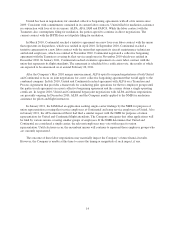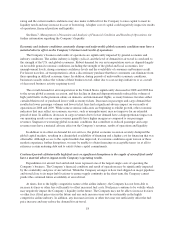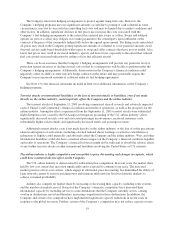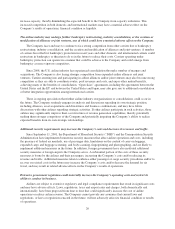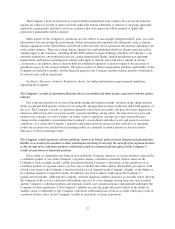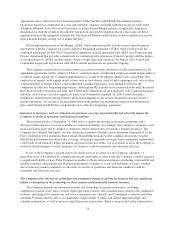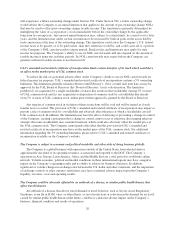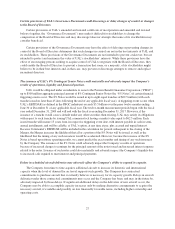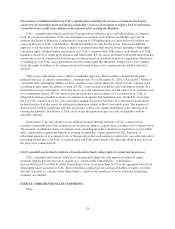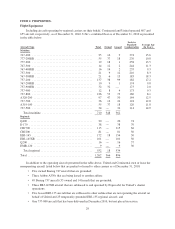United Airlines 2010 Annual Report Download - page 23
Download and view the complete annual report
Please find page 23 of the 2010 United Airlines annual report below. You can navigate through the pages in the report by either clicking on the pages listed below, or by using the keyword search tool below to find specific information within the annual report.Each of United and Continental operates under a certificate of public convenience and necessity issued by
the DOT. If the DOT altered, amended, modified, suspended or revoked these certificates, it could have a
material adverse effect on the Company’s business. The FAA from time to time also issues directives and other
regulations relating to the maintenance and operation of aircraft that require material expenditures or operational
restrictions by the Company, and which could include the temporary grounding of an entire aircraft type if the
FAA identifies design, manufacturing, maintenance or other issues requiring immediate corrective action. FAA
requirements cover, among other things, retirement of older aircraft, security measures, collision avoidance
systems, airborne windshear avoidance systems, noise abatement and other environmental concerns, aircraft
operation and safety and increased inspections and maintenance procedures to be conducted on older
aircraft. These FAA directives or requirements could have a material adverse effect on the Company.
In addition, the Company’s operations may be adversely impacted due to the existing antiquated air traffic
control (“ATC”) system utilized by the U.S. government. During peak travel periods in certain markets, the
current ATC system’s inability to handle existing travel demand has led to short-term capacity constraints
imposed by government agencies and resulted in delays and disruptions of air traffic. In addition, the current
system will not be able to effectively handle projected future air traffic growth. Imposition of these ATC
constraints on a long-term basis may have a material adverse effect on our results of operations. Failure to update
the ATC system in a timely manner, and the substantial funding requirements of a modernized ATC system that
may be imposed on air carriers may have an adverse impact on the Company’s financial condition or results of
operations.
The airline industry is subject to extensive federal, state and local taxes and fees that increase the cost of the
Company’s operations. In addition to taxes and fees that the Company is currently subject to, proposed taxes and
fees are currently pending and if imposed, would increase the Company’s operating expenses.
Access to landing and take-off rights, or “slots,” at several major U.S. airports and many foreign airports
served by the Company are, or recently have been, subject to government regulation. Certain of the Company’s
major hubs are among increasingly congested airports in the United States and have been or could be the subject
of regulatory action that might limit the number of flights and/or increase costs of operations at certain times or
throughout the day. The FAA may limit the Company’s airport access by limiting the number of departure and
arrival slots at high density traffic airports, which could affect the Company’s ownership and transfer rights, and
local airport authorities may have the ability to control access to certain facilities or the cost of access to its
facilities, which could have an adverse effect on the Company’s business. In addition, in 2008, the FAA planned
to withdraw and auction a certain number of slots held by airlines at the three primary New York area airports,
which the airlines challenged and the FAA terminated in 2009. If the FAA were to plan another auction that
survived legal challenge by the airlines, the Company could incur substantial costs to obtain such slots. Further,
the Company’s operating costs at airports at which it operates, including the Company’s major hubs, may
increase significantly because of capital improvements at such airports that the Company may be required to
fund, directly or indirectly. In some circumstances, such costs could be imposed by the relevant airport authority
without the Company’s approval and may have a material adverse effect on the Company’s financial condition.
The ability of U.S. carriers to operate international routes is subject to change because the applicable
arrangements between the United States and foreign governments may be amended from time to time, or because
appropriate slots or facilities may not be made available. The Company currently operates on a number of
international routes under government arrangements that limit the number of carriers permitted to operate on the
route, the capacity of the carriers providing services on the route, or the number of carriers allowed access to
particular airports. If an open skies policy were to be adopted for any of these routes, such an event could have a
material adverse impact on the Company’s financial position and results of operations and could result in the
impairment of material amounts of related tangible and intangible assets. In addition, competition from revenue-
sharing joint ventures and other alliance arrangements by and among other airlines could impair the value of the
Company’s business and assets on the open skies routes.
21





